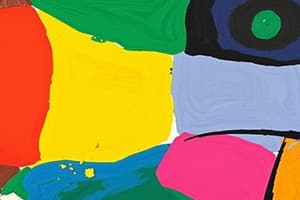Podcast
Questions and Answers
What is the main focus of art history?
What is the main focus of art history?
- Chronological development of art forms (correct)
- Cultural significance of art
- Emotional response to art
- Personal interpretation of artworks
Which assumption about art highlights its ability to communicate across cultures?
Which assumption about art highlights its ability to communicate across cultures?
- Art is universal (correct)
- Art is subjective
- Art involves experience
- Art is cultural
What aspect does art appreciation primarily emphasize?
What aspect does art appreciation primarily emphasize?
- The artist's biography
- Historical context of artworks
- Aesthetic appreciation and emotional response (correct)
- Techniques used in creating art
Which one of the following is NOT a form of 2D visual art?
Which one of the following is NOT a form of 2D visual art?
How does art serve as a reflection of cultural context?
How does art serve as a reflection of cultural context?
Which of the following descriptions best fits printmaking?
Which of the following descriptions best fits printmaking?
Which of the following best captures the nature of visual art?
Which of the following best captures the nature of visual art?
What is a key characteristic of 2D visual arts?
What is a key characteristic of 2D visual arts?
What purpose of art does Aristotle emphasize with his view on tragedy?
What purpose of art does Aristotle emphasize with his view on tragedy?
According to Kant, aesthetic judgments require what type of approach toward artworks?
According to Kant, aesthetic judgments require what type of approach toward artworks?
Leo Tolstoy believed that the primary function of art is to:
Leo Tolstoy believed that the primary function of art is to:
What distinguishes representational art from non-representational art?
What distinguishes representational art from non-representational art?
Which of the following is an example of non-representational art?
Which of the following is an example of non-representational art?
What is the main focus of Kant's assessment of beauty in art?
What is the main focus of Kant's assessment of beauty in art?
Which type of art focuses primarily on recognizable objects to convey meaning?
Which type of art focuses primarily on recognizable objects to convey meaning?
What does Aristotle consider a function of art related to human hardships?
What does Aristotle consider a function of art related to human hardships?
What defines three-dimensional art?
What defines three-dimensional art?
Which of the following is an example of installation art?
Which of the following is an example of installation art?
What is the primary concern of the physical function of art?
What is the primary concern of the physical function of art?
How did Plato view the role of art in relation to true knowledge?
How did Plato view the role of art in relation to true knowledge?
According to Aristotle, what is the purpose of art?
According to Aristotle, what is the purpose of art?
Which of the following might exemplify art's social function?
Which of the following might exemplify art's social function?
How did Plato's philosophy influence perceptions of art?
How did Plato's philosophy influence perceptions of art?
What is a common characteristic of sculpture as a form of 3D art?
What is a common characteristic of sculpture as a form of 3D art?
What does the source of subject 'personal experiences' in art primarily depict?
What does the source of subject 'personal experiences' in art primarily depict?
Which of the following is an example of content in art?
Which of the following is an example of content in art?
What does 'symbolic meaning' in levels of meaning refer to?
What does 'symbolic meaning' in levels of meaning refer to?
Which artwork represents a historical event through its composition?
Which artwork represents a historical event through its composition?
What is an example of a personal level of meaning in art?
What is an example of a personal level of meaning in art?
Which of the following best describes the literal level of meaning in art?
Which of the following best describes the literal level of meaning in art?
In which source of subject does 'nature' play a primary role?
In which source of subject does 'nature' play a primary role?
What common misconception might people have about content in art?
What common misconception might people have about content in art?
Flashcards are hidden until you start studying
Study Notes
Assumptions and Nature of Arts: Creativity, Imagination
- Art history and art appreciation are separate fields; the former investigates chronological developments, while the latter focuses on subjective experiences and emotional engagement with artworks.
- Art is universal, conveying emotions and ideas that transcend cultural boundaries, reflecting shared human experiences.
- Art is cultural, embodying society's beliefs and traditions, shaped by historical events and social norms, leading to diverse forms and meanings across cultures.
- Art involves experience, fostering emotional and personal connections for both artists and viewers, enhancing perceptions through sensory engagement.
Visual Art
- Visual art employs colors, shapes, lines, and textures to evoke emotions and experiences, reshaping perspectives through creative expression.
- 2D Visual Arts include:
- Painting: Uses pigments on surfaces like canvas to depict scenes and emotions.
- Drawing: Represents images with various tools on surfaces, ranging from realistic to abstract styles.
- Printmaking: Techniques such as etching and screen printing reproduce artworks.
- Aristotle viewed art as a source of pleasure and moral lessons, exemplified by tragedy in works like "Oedipus Rex".
- Kant's Idea of Disinterested Judgment emphasizes objective assessment of artwork's beauty, distinct from personal preferences, requiring detached contemplation of universal aesthetic qualities.
- Tolstoy's Emotion Communication theory posits that art conveys emotions from creators to audiences, uniting people through shared feelings.
Subject and Content
- Art subjects can be representational or non-representational.
- Representational art depicts recognizable objects and scenes, evolving with cultural contexts (e.g., portraits, landscapes).
- Non-representational art utilizes colors and forms to express ideas without recognizable subjects (e.g., Abstract Expressionism).
3D Visual Arts
- 3D Visual Arts involve height, width, and depth, manifesting in:
- Sculpture: Creating figures from materials like stone or clay.
- Architecture: Designing buildings and structures.
- Installation Art: Large-scale projects tailored for specific spaces using diverse materials.
Functions of Art
- Art serves various functions:
- Physical Function: Tangible designs integrating artistic elements, such as artistically designed furniture.
- Social Function: Engaging with public issues through art, like murals that celebrate cultural diversity.
- Personal Function: Self-expression through introspective artworks, such as self-portraits.
Basic Philosophical Perspectives
- Plato's Art as Imitation suggests art distracts from true knowledge by presenting imperfect copies of ideal forms, advocating for restrictions on art.
- Aristotle's Art as Representation sees art as a medium for understanding different realities, supporting philosophical inquiry.
Sources of Subject
- Artistic subjects derive from:
- Personal Experiences: Capturing artists' emotions and narratives through personal life events (e.g., Frida Kahlo's self-portraits).
- Nature: Reflecting the beauty of natural landscapes (e.g., Ernest Walbourn's "Flowers of the Field").
- History: Documenting and interpreting significant events (e.g., "The Death of Marat" by David).
Content in Art
- Content encompasses the ideas, emotions, and narratives expressed in artworks, shaped through various techniques.
Levels of Meaning
- Literal Meaning: The straightforward depiction of a subject (e.g., a bowl of fruit).
- Symbolic Meaning: Use of symbols to represent abstract concepts (e.g., a red rose symbolizing love).
- Personal Meaning: Influenced by viewers' life experiences, beliefs, and emotions, leading to varied interpretations of artworks.
Studying That Suits You
Use AI to generate personalized quizzes and flashcards to suit your learning preferences.




